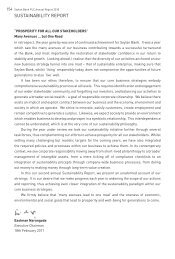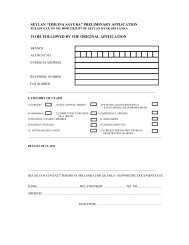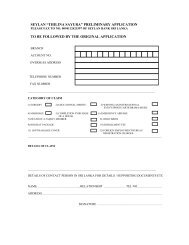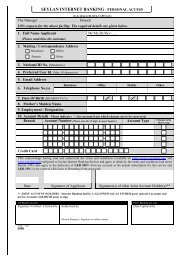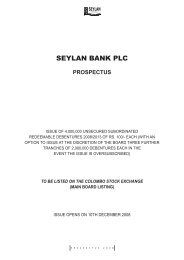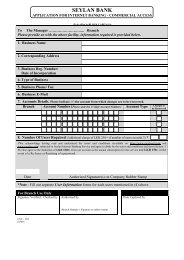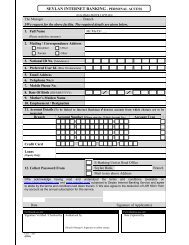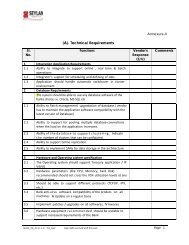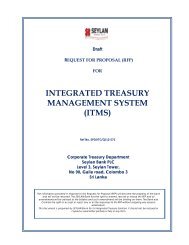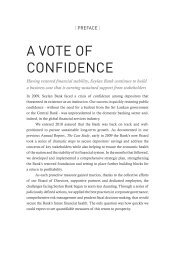Notes to the Consolidated Financial Statements - Seylan Bank
Notes to the Consolidated Financial Statements - Seylan Bank
Notes to the Consolidated Financial Statements - Seylan Bank
You also want an ePaper? Increase the reach of your titles
YUMPU automatically turns print PDFs into web optimized ePapers that Google loves.
North Bound > <strong>Seylan</strong> <strong>Bank</strong> Annual Report 2011<br />
283<br />
3.4.6.2 Termination Benefits<br />
Termination benefits are recognised as an expense when <strong>the</strong> <strong>Bank</strong> is committed demonstrably, without<br />
realistic possibility of withdrawal, <strong>to</strong> a formal detailed plan <strong>to</strong> ei<strong>the</strong>r terminate employment before <strong>the</strong><br />
normal retirement date, or <strong>to</strong> provide termination benefits as a result of an offer made <strong>to</strong> encourage<br />
voluntary redundancy. Termination benefits for voluntary redundancies are recognised if <strong>the</strong> <strong>Bank</strong> has<br />
made an offer of voluntary redundancy, it is probable that <strong>the</strong> offer will be accepted, and <strong>the</strong> number of<br />
acceptances can be estimated reliably.<br />
3.4.6.3 Defined Contribution Plans<br />
A defined contribution plan is a post-employment plan under which an entity pays fixed contributions<br />
in<strong>to</strong> a separate entity and will have no legal or constructive obligation <strong>to</strong> pay a fur<strong>the</strong>r amount. Obligations<br />
for contributions <strong>to</strong> defined contribution plans are recognised as expense in profit or loss as and when <strong>the</strong>y<br />
are due.<br />
3.4.6.3 (a) Employees’ Provident Fund<br />
The <strong>Bank</strong> and employees contribute 12% and 8% respectively, on <strong>the</strong> salary of each employee <strong>to</strong> <strong>the</strong> approved<br />
Private Provident Fund. [Refer Note 10]<br />
3.4.6.3 (b) Employees’ Trust Fund<br />
The <strong>Bank</strong> contributes 3% of <strong>the</strong> salary of each employee <strong>to</strong> <strong>the</strong> Employees’ Trust Fund (ETF). The <strong>to</strong>tal<br />
amount recognised as an expense <strong>to</strong> <strong>the</strong> <strong>Bank</strong> for contribution <strong>to</strong> ETF is disclosed in <strong>the</strong> <strong>Notes</strong> <strong>to</strong> <strong>Financial</strong><br />
<strong>Statements</strong>. [Refer Note 10]<br />
3.4.6.4 Short-Term Benefits<br />
Short-term employee benefits are measured on an undiscounted basis and are expensed as <strong>the</strong> related<br />
service is provided.<br />
A liability is recognised for <strong>the</strong> amount expected <strong>to</strong> be paid under short-term compensated absences if<br />
<strong>the</strong> <strong>Bank</strong> has a present legal or constructive obligation <strong>to</strong> pay as a result of past services provided by <strong>the</strong><br />
employees and <strong>the</strong> obligation can be estimated reliably. Leave encashment provision has been computed<br />
for <strong>the</strong> annual leave entitlement up <strong>to</strong> a maximum of 90 working days that could be carried forward up <strong>to</strong> <strong>the</strong><br />
date of retirement by <strong>the</strong> staff member.<br />
3.4.6.5 Provisions<br />
A provision is recognised if, as a result of a past event, <strong>the</strong> <strong>Bank</strong> has a present legal or constructive obligation<br />
that can be estimated reliably, and it is probable that an outflow of economic benefits will be required <strong>to</strong><br />
settle <strong>the</strong> obligation.<br />
A provision for onerous contracts is recognised when <strong>the</strong> expected benefits <strong>to</strong> be derived by <strong>the</strong> <strong>Bank</strong> from<br />
a contract are lower than <strong>the</strong> unavoidable cost of meeting its obligations under <strong>the</strong> contract. The provision<br />
is measured at <strong>the</strong> present value of <strong>the</strong> lower of <strong>the</strong> expected cost of terminating <strong>the</strong> contract and <strong>the</strong><br />
expected net cost of continuing with <strong>the</strong> contract before a provision is established, <strong>the</strong> <strong>Bank</strong> recognises any<br />
impairment loss on <strong>the</strong> assets associated with that contract.



